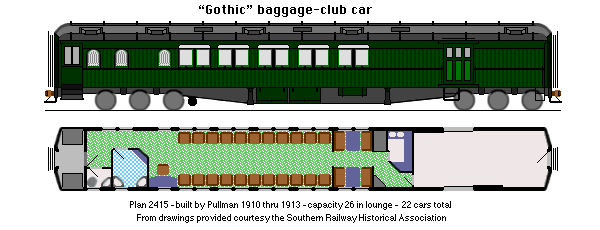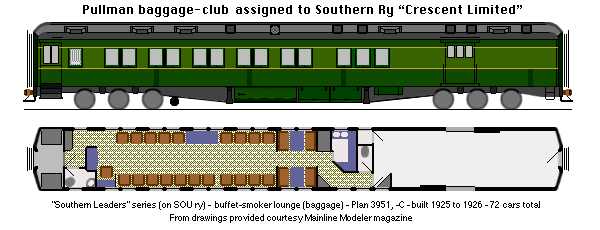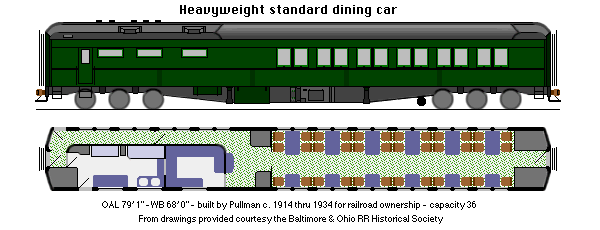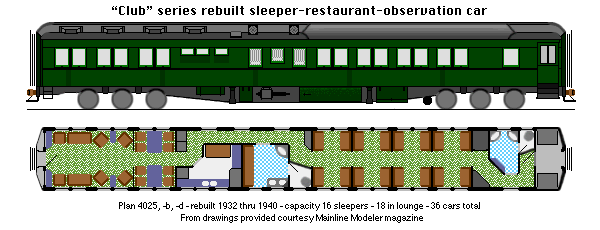
Content provided by Those Classic Trains

The earliest steel cars were built for the roads that radiate out from New York City: the NYC and PRR heading west, the Southern Ry and the Florida Trade heading south. Thus the Plan 2415 baggage-club is popular in the East and South.
The club car has long been a male bastion; a place of cigars and whiskey, politicians and businessmen, wheeling and dealing, brass spittoons, card sharps and high stakes poker games. All that is missing is a rinky-tink piano (and some trains have had that as well). It is very much a Mans World here: there is only one public restroom. (There is, however, a salon where the ladies may freshen up).
The buffet serves sandwiches, snacks and (mostly) drinks. On some cars, the buffet has been replaced by a bar.
Up forward, the baggage section has taken that function over from the combine coaches formerly used in long haul service. Normally, there is no messenger assigned to a baggage car, but the club car steward usually handles that task.

Within a few years time, the design of baggage-clubs has matured to this Plan 3951 car assigned to the Southern Ry.
The clientele is more sedate now than in the rowdy old days of the Varnish club cars, and these clubs are the scene of reading, politics and socializing. (And smoking.) The writing desk has been supplemented by the now traditional bookcase. In the place of Leslies Weekly or The Police Digest, the rack now holds Life, Look and Time, and perhaps the National Geographic. Social equality has arrived in the form of a second restroom at the forward end of the club section.
At the other end, the baggage section is enlarged by building the front of the car out the same way as the rear. The earlier 2415s are shortened so that the front of the baggage-club has the same coupling length as the head end cars in front of it. However, this has not proven to be a problem, and the ability to use the universal Pullman carbody is a clincher.
The baggage-club at the forward end of the train and the lounge-observation at the rear end provide all the recreational facilities found on most Standard Era consists. Only in the Depression, as the railroads fight to keep their customers, will mid-train lounges be included.

This is your typical 36 seat full dining car found on trains throughout the country. The crew is a Steward (in charge), 6 waiters (one for each pair of tables) 3 cooks and a helper (who washes dishes).
The kitchen section, at left, has an ice box, grille, steam table, preparation table and dishwashing sink. Finished food is passed through a window to the pantry. The public hallway runs around the kitchen- so typically the kitchen measures about 7 feet by 20 feet. The floor is covered with a wooden grille so that scraps can fall through and be hosed out later.
Next to the ice box is the provisioning door where the Commissary Department loads supplies. The opposite side provisioning door is at the end of the car, where packages can be run directly into the kitchen. At major reprovisioning stations, the Commissary truck will be spotted so that the arriving diner stops right next to it, thus reducing loading time.
Cooking is done in a large coal fired stove-oven-grille (shown in white on the left side of the kitchen). The steam table (at right) uses hot water provided by the coal stove. In some later cars, attempts have been made to use train line steam, but this is generally not satisfactory. Coal is loaded aboard in sacks prior to departure and, on some cars, is stored in underbody boxes that can be accessed through a trap door in the kitchen floor.
At the left end of the car is the roof ice hatch through which ice is loaded into the refrigeration bunker. During icing, some ice is transferred to lockers in the pantry for the chill table and for drinks. The kitchen is not air conditioned, but traditional ventilators on the roof provide some relief.
The pantry contains the bread locker, chill table, drinks, coffee pot and related tableware. Linens are stored in lockers under the counter and in the middle of the car. Here the waiters put the finishing touches on meals before taking them out. One waiter usually doubles as the pantry man to keep it cleaned and stocked.
The dining section, at right, is the traditional 36 seat configuration dating back to the Varnish era. Each waiter has one pair of tables (6 seats total). Lockers at the end of the car hold more linens and cleaning supplies.
In the Standard Era, dining cars were cut in and out at regular stops. The crews could sleep at the local railroad hotels and the cars reprovisioned and put on another train. As the Depression deepens, most of the major trains keep their diners as dedicated equipment. This requires a dormitory section for the crew. The advantages are reduced schedule times (from not having to stop and cut diners in and out) and the diner can also be used as a mid-train lounge in off hours.
As a rule of thumb, many railroads limit passenger load to 100 passengers per diner. So it is not uncommon to see two diners, either facing back to back in the mid-train or spaced throughout the consist.

In the Depression years, traditional diners have become uneconomical on many routes. Further, both Pullman and the railroads are always looking for ways to make every car provide revenue. Then too, there are all those surplus "Gothic" cars sitting on storage tracks around the country. What has emerged from all these is a distinctive breed of multi-purpose cars.
These cars can feature any combination of sections (4 to 12), parlor seats (6 to 20), chair or coach seats (8 to 30), one or more lounges (one usually designated as a smoking section), a restaurant with seating from 8 to 24, a buffet and/or a sun room. There are any number of these designs, usually built in lots of 1 to 6. With 36 cars total, the Plan 4025, shown here, is the most widespread of them all.
The Plan 4025 has 8 sections (rooms are rare on these cars), a restaurant with dining section for 8 and a lounge. These cars have windows in the rear so that they can act as observation cars when cut out on a separate section. In this service, they run as mid-train lounges prior to being cut out.
The cars are air conditioned with the retrofitted roof ducts. Note that the kitchen and restroom are not air conditioned, but the restroom is ventilated by electric fans. The A/C duct for the lounge runs along the other side of the roof. The probable reason for the ventilators over the lounge is so it may be used as a smoking section.
Food accommodations will vary. A buffet is usually a small kitchen facility capable of preparing sandwiches, drinks and snacks. A restaurant is a larger facility that can prepare cooked meals- being, in effect, a miniature diner sharing a carbody with another accommodation like some sections. Cooking is done with a coal fired stove while refrigeration is by ice loaded through a roof hatch.
These cars reduce operating costs on smaller Depression-era trains and allow trains to be combined into joint runs, with the respective sections combining and splitting as desired. They are also useful on all coach runs, providing sleeper, lounge and dining capacity all in one car.
Refer to "Free Downloads" for a summary of Pullman car types.
| Home Site Map Search Contact |
North East Rails © Clint Chamberlin. |